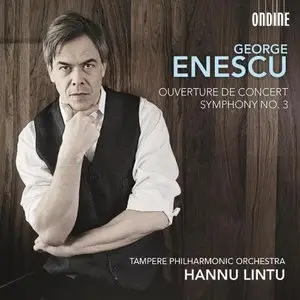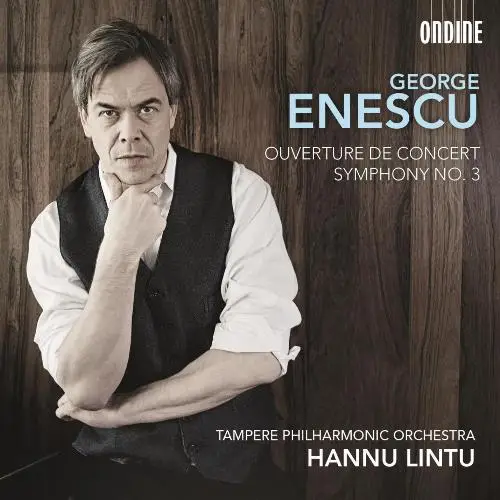Hannu Lintu, Tampere Philharmonic Orchestra - George Enescu: Symphony No. 3; Ouverture De Concert (2013)
EAC Rip | Flac (Image + cue + log) | 1 CD | Full Scans | 227 MB
Genre: Classical | Label: Ondine | Catalog Number: 1197
EAC Rip | Flac (Image + cue + log) | 1 CD | Full Scans | 227 MB
Genre: Classical | Label: Ondine | Catalog Number: 1197
Ondine is pleased to announce the second CD in their Enescu cycle. The first release featuring Symphony No. 2 and the Chamber Symphony Op. 33 was highly praised by critics and nominated for the Gramophone Awards 2013. Enescu is Romania’s most notable composer – and one of the most neglected composers of the 20th century. This release demonstrates a master of orchestral colour and impressive imagination.
Artistic director of the Tampere Philharmonic Orchestra from 2009-2013, Hannu Lintu is a sought-after conductor and from 2013/14 assumes the post of chief conductor of the Finnish RSO
Composer: George Enescu
Conductor: Hannu Lintu
Orchestra/Ensemble: Tampere Philharmonic Orchestra
Reviews: I earlier characterized Enescu’s Second Symphony (finished in 1914) as the “least interesting of the three he finished. It was an ambitious effort to extend the symphonic form through dense musical paragraphs….[T]he whole thing was parlayed into a blazingly affirmative, contrapuntal apotheosis—while utilizing throughout the musical language of Richard Strauss: serpentine melodies, harmonic side-slipping, and superfluous detail in the accompaniment.” By the time the composer had put the final touches to his Third Symphony, his style had undergone several profound changes. The Straussian influence had for the most part receded, though the Bavarian’s bold orchestral treatment remained fully in place (and his thick textures became an element of contrast instead of a regular feature). Chromatic violin figurations, alternating with reduced winds, at times created an almost chamber-like character. Folk characteristics became more ingrained: free rhythms, engaging both melody and ornamentation (for which Bartók coined the term parlando rubato ) alternated with dance-like passages. The sonata- allegro structure, with its clear-cut themes, bridges, and development was largely replaced by a transformative structure built around a few themes and their sequences of motifs. This allowed Enescu to engage in his habit of cross-referencing among all three lengthy movements without let.
Expressively, it is a work of sudden dynamic shifts in character that almost begs for programmatic interpretation—certainly one among several good reasons you won’t find any here. The liner notes drag in Tchaikovsky’s Sixth Symphony because in both works a scherzo leads to a slow finale, but the two couldn’t be further apart in character. Enescu’s Scherzo isn’t manic, but exuberant and Lalo-playful, before and after a threatening episode that thematically recalls the opening moderato movement; while his lento Finale, complete with wordless chorus, is a spacious piece, alternately serene and exultant, that overcomes the repeated attempt of some first movement fragments to upset its glowing core. Other such fragments are tossed, along with second movement ones, into the cauldron.
I regard Enescu’s Third as one of the finest of 20th-century symphonies, yet it has received few recordings over the years. Much the same can be said of the Concert Overture on Themes of a Popular Romanian Character from 1948. A fresh, inventive work that’s easy to enjoy, it hides Enescu’s profound transformative skill behind brilliant orchestration and kaleidoscopically varied thematic material. That it isn’t better known, blame on unimaginative concert programming, and complexities of meter, tonal center, and textural balance.
After the recording of Enescu’s Second Symphony and his Chamber Symphony by Lintu with his Tampere musicians ( Fanfare 36:2 for reviews by Jerry Dubins and myself, 36:3 for that of Ronald Grames), I was looking forward to their next series release. It confirms their mastery of Enescu’s difficult idiom. Lintu keeps the precarious balance between detail and momentum from bogging down in the former, and navigates the apparently non-rhythmic expanses that periodically occur in both works as though this were the simplest matter in the world. He teases out the endless cross-references without underscoring them, and negotiates Enescu’s breaks of mood, texture, and meter with ease. The Symphony’s Scherzo has great kinetic punch, and the Finale avoids losing its clarity in the many strands of diaphanous strata. The Tampere Philharmonic is always tightly disciplined and plays with a lean, beautiful sound, without any surface richness to detract from Enescu’s textures.
As for the Third Symphony’s competition, Mandeal/Bucharest Phiharmonic (Arte Nova 37860) grinds to a halt in the details, though the conductor is, as ever, insightful. Baciu/Cluj-Napoca Philharmonic (Marco Polo 223143) completely loses sight of clarity, and turns the work into a ponderous morass. Rozhdestvensky/BBC Philharmonic has some good ideas, especially in the Finale, and a fine orchestra, but ends up being defeated by a cathedral ambiance. Foster/Lyon National Orchestra (EMI Classics 6783932) offers a bland reading and an outclassed ensemble. In the Concert Overture , Mandeal and his Bucharest musicians once again grind to a halt while finessing the textures. Silvestri (Marco Polo 223144) is as good as Lintu with rather more heart on his sleeve, but is let down by sloppy playing from the Romanian RSO. I have not heard Alexandru Lascae/Philharmonia Moldova (Ottavo 69450).
This is a clean sweep, in other words. If someone releases Silvestri and the Bournemouth SO in one of these two works during the period he was their principal conductor in the 1960s, it’s just possible Lintu might have some formidable competition. The Bournemouth certainly wasn’t the jewel of an orchestra it would eventually become, but it was more disciplined than the Romanian RSO.
But that’s a big “if.” And even if that did happen, what Lintu and the Tampere Philharmonic offer here are performances that deserve to be on your Want List. They certainly will be on mine in 2014.
Tracklisting:
Concert Overture on popular Romanian themes in A Major, Op. 32
1. Concert Overture on popular Romanian Themes in A Major, Op. 32 00:09:12
Symphony No. 3 in C Major, Op. 21
2. I. Moderato, un poco maestoso 00:16:17
3. II. Vivace, ma non troppo 00:13:35
4. III. Lento, ma non troppo 00:16:17
Exact Audio Copy V1.0 beta 3 from 29. August 2011
EAC extraction logfile from 28. May 2014, 17:46
Tampere Philharmonic Orchestra, Hannu Lintu / Enescu - Ouverture de concert & Symphony No.3
Used drive : HL-DT-STDVDRRW GWA-4164B Adapter: 5 ID: 0
Read mode : Secure
Utilize accurate stream : Yes
Defeat audio cache : Yes
Make use of C2 pointers : No
Read offset correction : 102
Overread into Lead-In and Lead-Out : No
Fill up missing offset samples with silence : Yes
Delete leading and trailing silent blocks : No
Null samples used in CRC calculations : Yes
Used interface : Native Win32 interface for Win NT & 2000
Used output format : User Defined Encoder
Selected bitrate : 896 kBit/s
Quality : High
Add ID3 tag : No
Command line compressor : C:\Program Files\Exact Audio Copy\FLAC\FLAC.EXE
Additional command line options : -V -8 %source%
TOC of the extracted CD
Track | Start | Length | Start sector | End sector
––––––––––––––––––––––––––––-
1 | 0:00.00 | 9:21.64 | 0 | 42138
2 | 9:21.64 | 16:17.72 | 42139 | 115485
3 | 25:39.61 | 13:35.48 | 115486 | 176658
4 | 39:15.34 | 16:17.19 | 176659 | 249952
Range status and errors
Selected range
Filename D:\temp\Music\Enescu - Ouverture de concert & Symphony No.3\Enescu - Ouverture de concert & Symphony No.3.wav
Peak level 96.7 %
Extraction speed 3.6 X
Range quality 100.0 %
Test CRC D4CEA341
Copy CRC D4CEA341
Copy OK
No errors occurred
AccurateRip summary
Track 1 not present in database
Track 2 not present in database
Track 3 not present in database
Track 4 not present in database
None of the tracks are present in the AccurateRip database
End of status report
==== Log checksum B2822CC323CEB147F6BD1F0A8478DCDC503DDB139F0FC668F57AD25CC00A807D ====
EAC extraction logfile from 28. May 2014, 17:46
Tampere Philharmonic Orchestra, Hannu Lintu / Enescu - Ouverture de concert & Symphony No.3
Used drive : HL-DT-STDVDRRW GWA-4164B Adapter: 5 ID: 0
Read mode : Secure
Utilize accurate stream : Yes
Defeat audio cache : Yes
Make use of C2 pointers : No
Read offset correction : 102
Overread into Lead-In and Lead-Out : No
Fill up missing offset samples with silence : Yes
Delete leading and trailing silent blocks : No
Null samples used in CRC calculations : Yes
Used interface : Native Win32 interface for Win NT & 2000
Used output format : User Defined Encoder
Selected bitrate : 896 kBit/s
Quality : High
Add ID3 tag : No
Command line compressor : C:\Program Files\Exact Audio Copy\FLAC\FLAC.EXE
Additional command line options : -V -8 %source%
TOC of the extracted CD
Track | Start | Length | Start sector | End sector
––––––––––––––––––––––––––––-
1 | 0:00.00 | 9:21.64 | 0 | 42138
2 | 9:21.64 | 16:17.72 | 42139 | 115485
3 | 25:39.61 | 13:35.48 | 115486 | 176658
4 | 39:15.34 | 16:17.19 | 176659 | 249952
Range status and errors
Selected range
Filename D:\temp\Music\Enescu - Ouverture de concert & Symphony No.3\Enescu - Ouverture de concert & Symphony No.3.wav
Peak level 96.7 %
Extraction speed 3.6 X
Range quality 100.0 %
Test CRC D4CEA341
Copy CRC D4CEA341
Copy OK
No errors occurred
AccurateRip summary
Track 1 not present in database
Track 2 not present in database
Track 3 not present in database
Track 4 not present in database
None of the tracks are present in the AccurateRip database
End of status report
==== Log checksum B2822CC323CEB147F6BD1F0A8478DCDC503DDB139F0FC668F57AD25CC00A807D ====
Thanks to the original releaser



